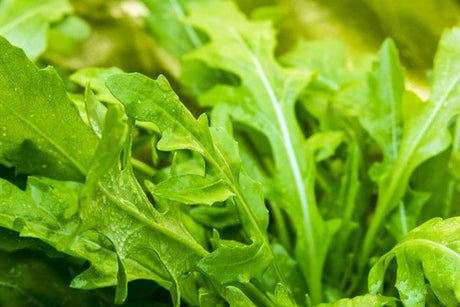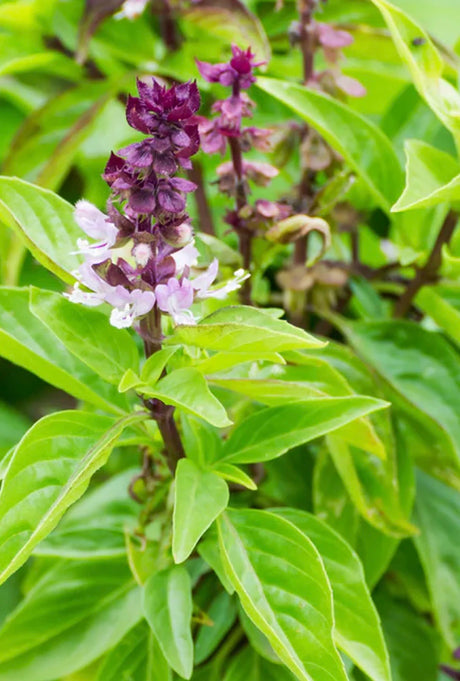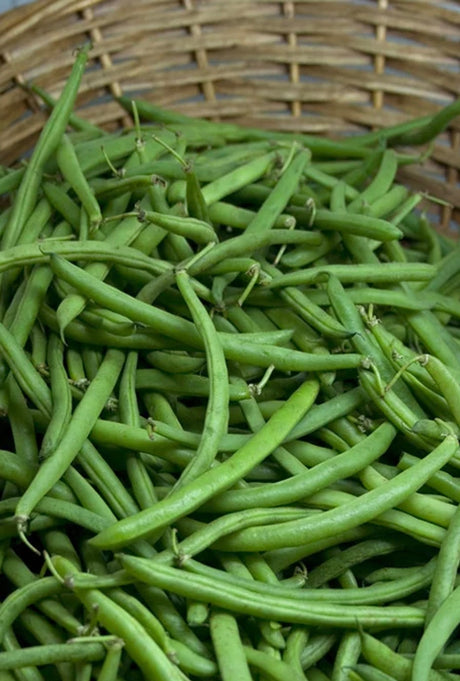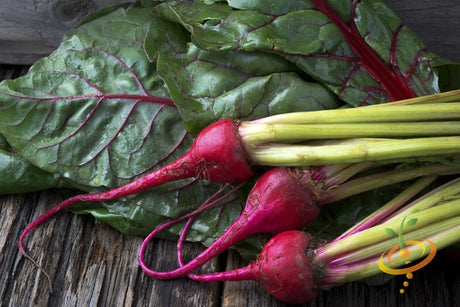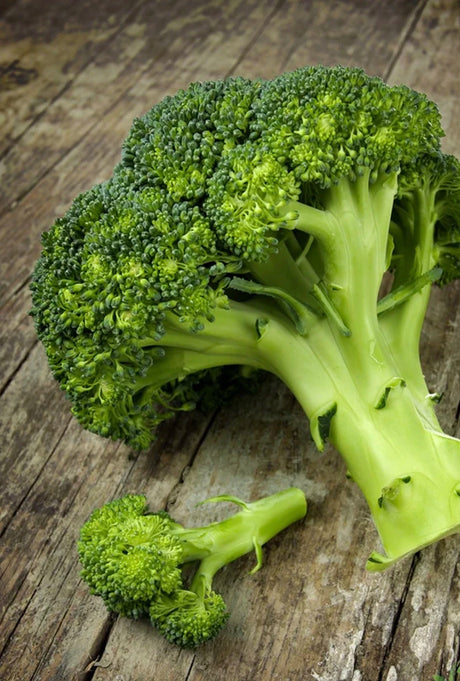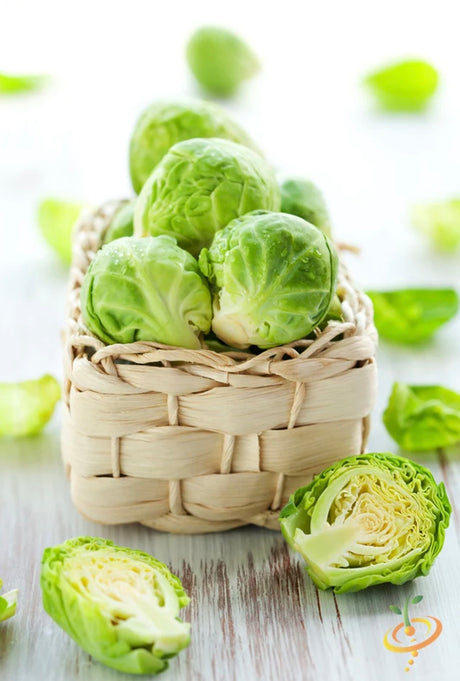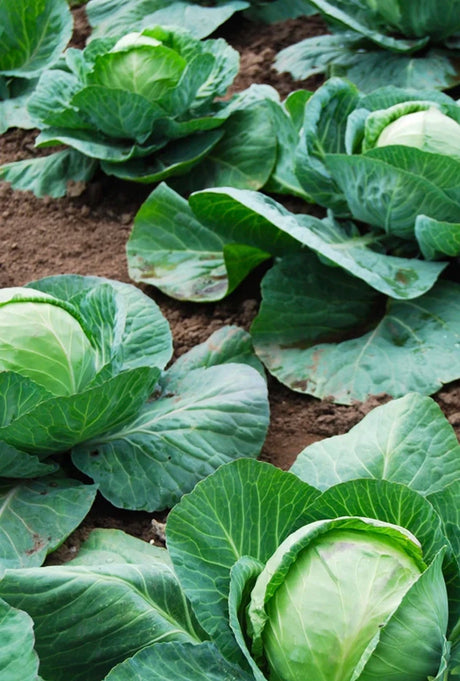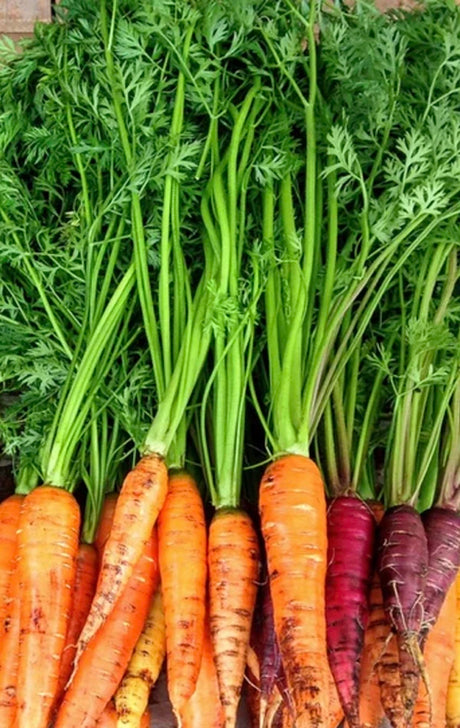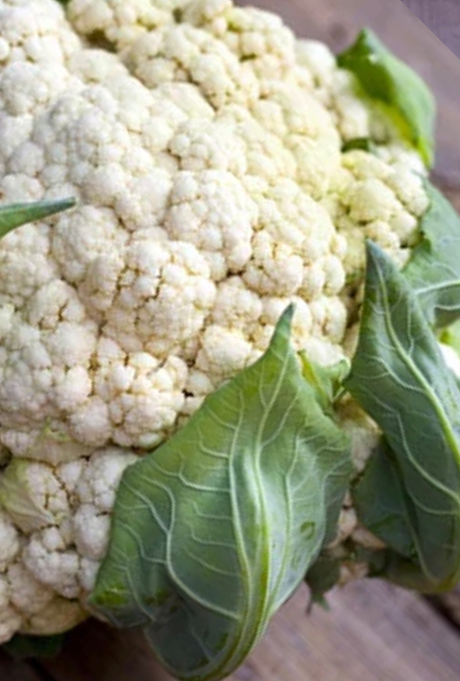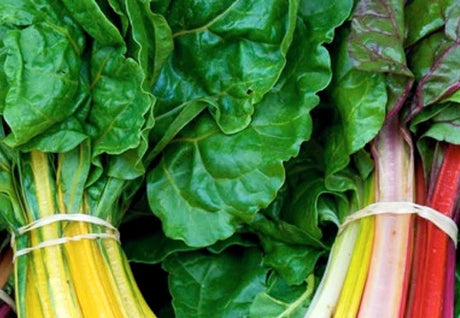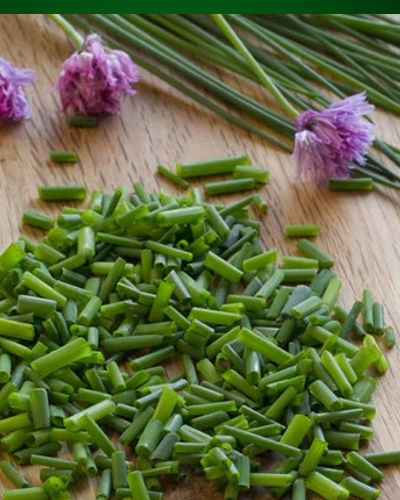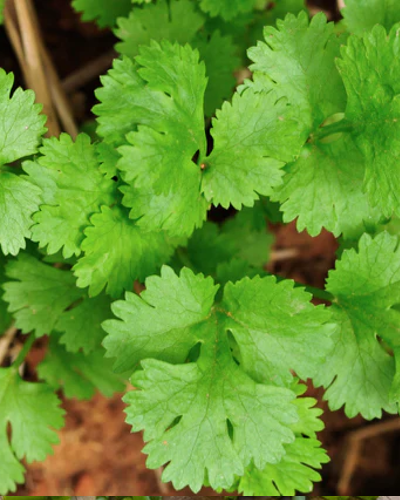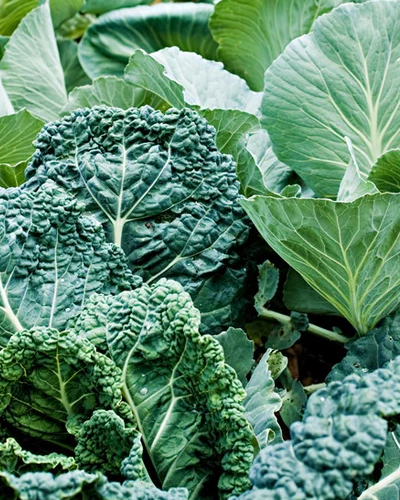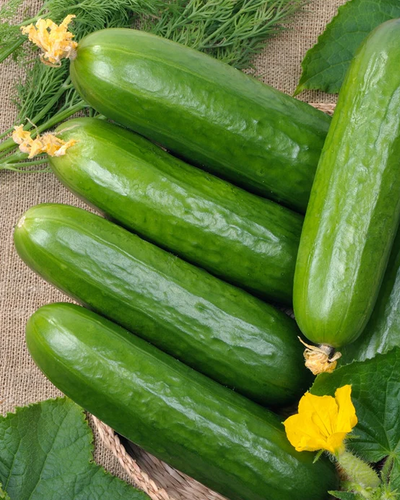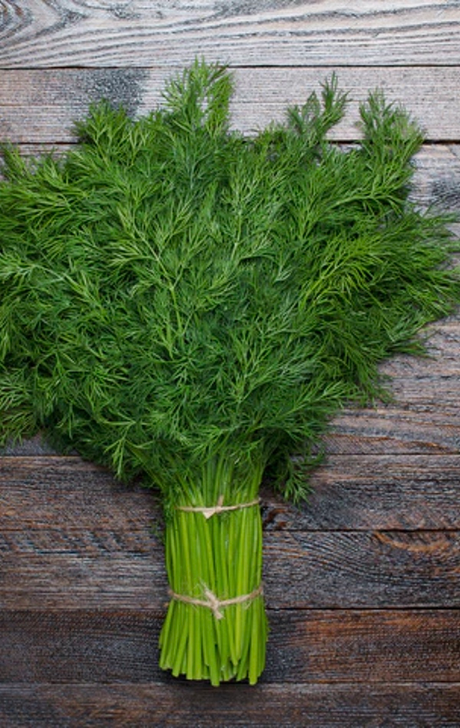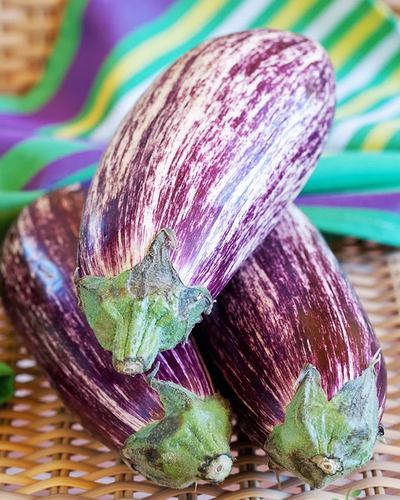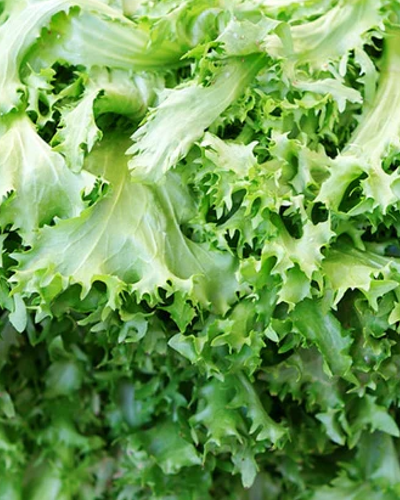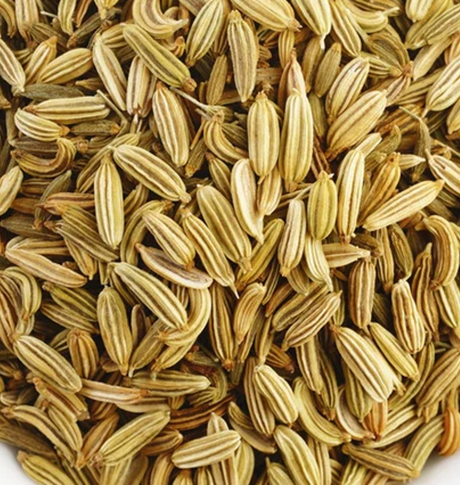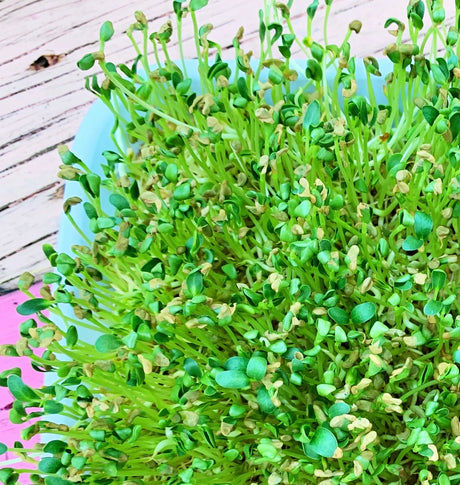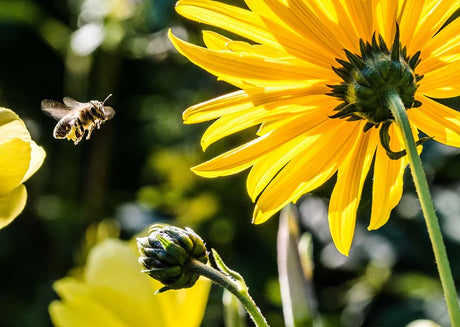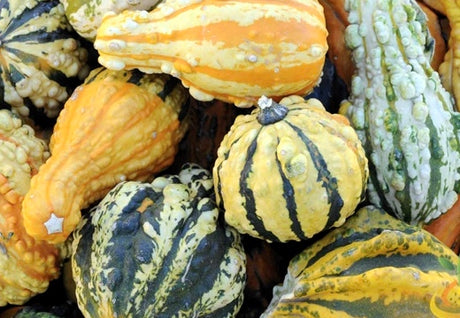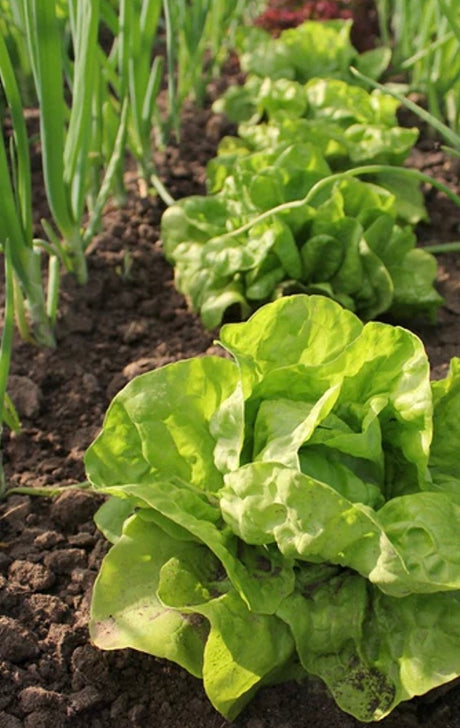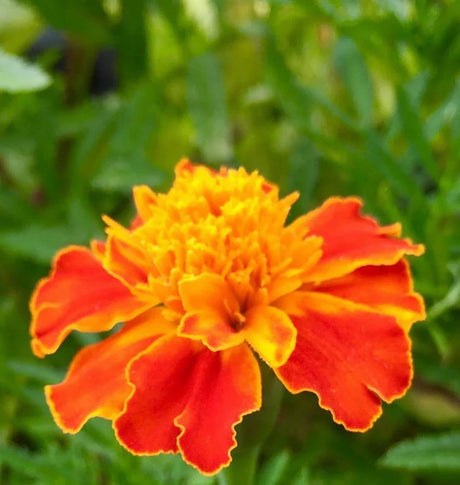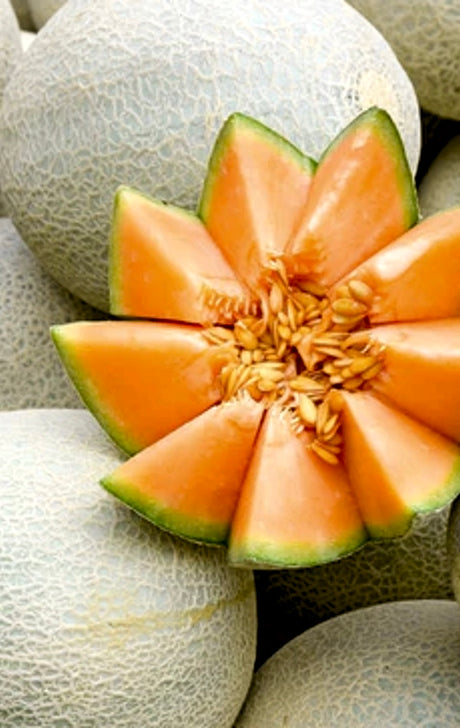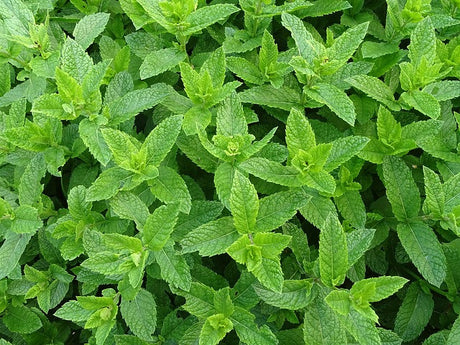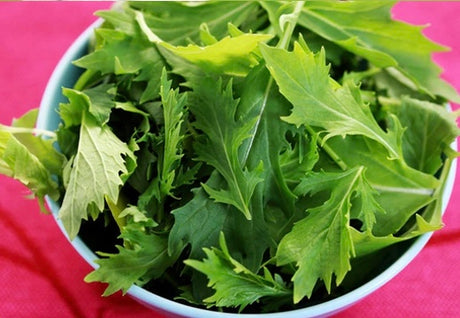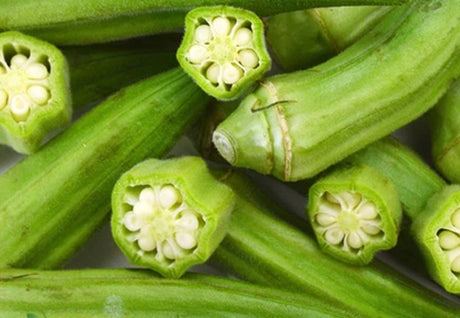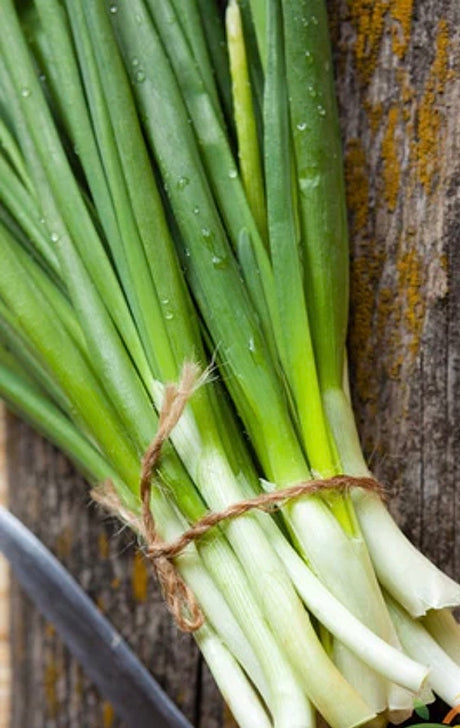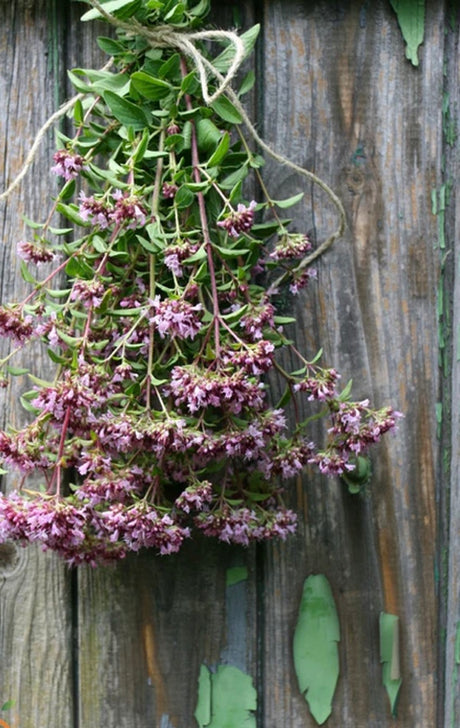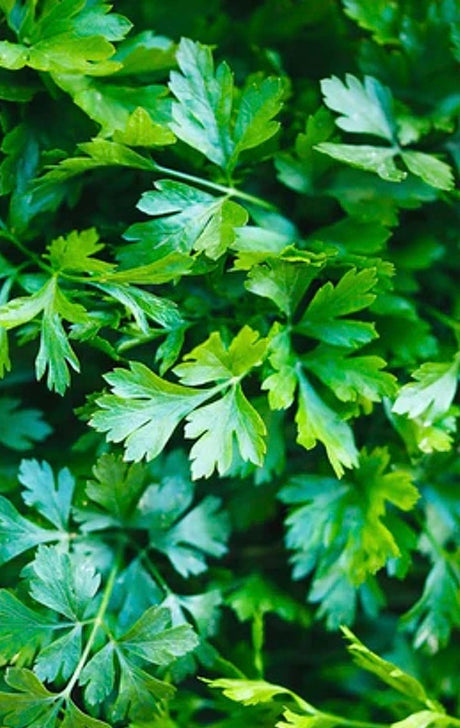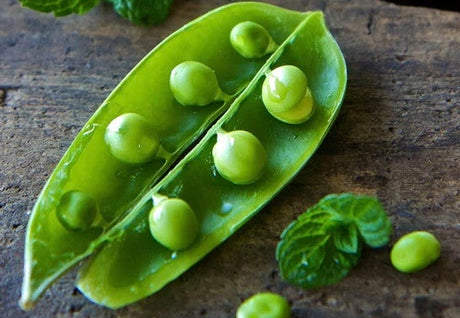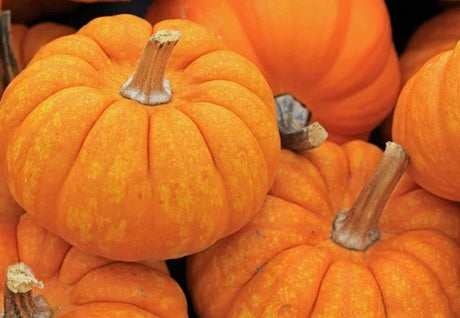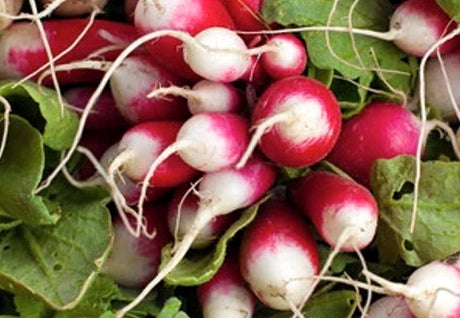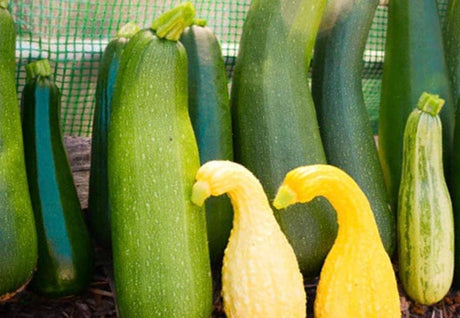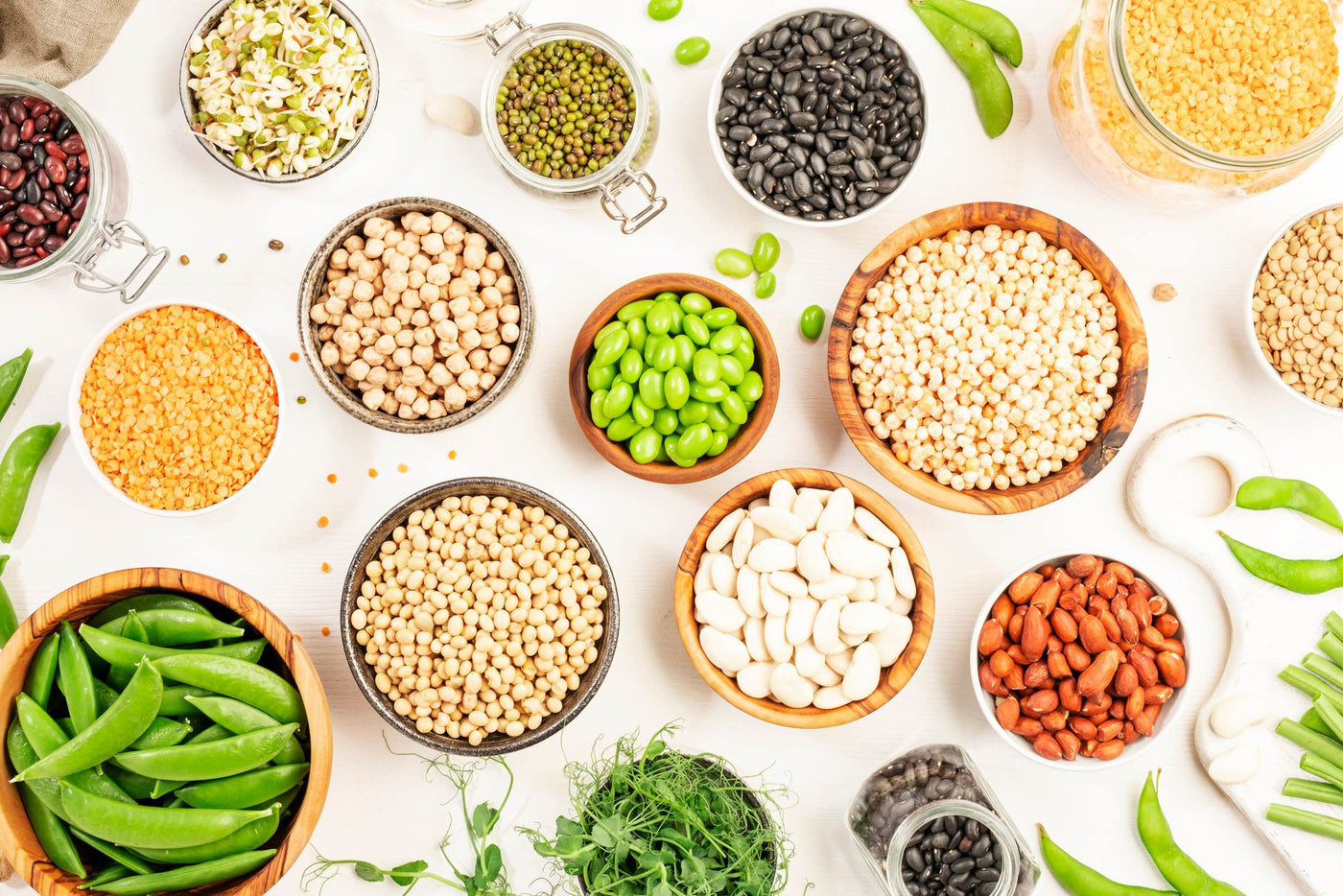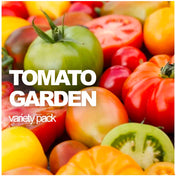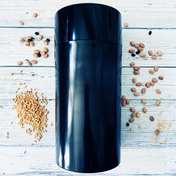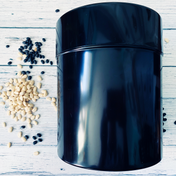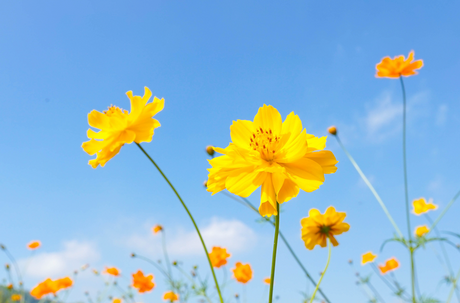Carrot - Scarlet Nantes, 6-7" Long
From $399 USDUnit price /UnavailableDescription
The Scarlet Nantes carrot (Daucus carota subsp. sativus) is a popular variety among home gardeners due to its exceptional flavor, vibrant color, and adaptability to various growing conditions. This heirloom cultivar is characterized by its cylindrical shape, smooth skin, and sweet, crisp texture, making it an ideal choice for both fresh consumption and culinary applications.
Scarlet Nantes carrots typically reach a length of 6 to 7 inches and are known for their bright orange hue, which is indicative of their high beta-carotene content. Beta-carotene is a precursor to vitamin A, essential for maintaining healthy vision, immune function, and skin health. Studies have shown that orange carrots, such as Scarlet Nantes, can contain up to 14,000 micrograms of beta-carotene per 100 grams, contributing significantly to daily nutritional requirements.
This variety thrives in well-drained, loamy soil with a pH range of 6.0 to 6.8. Carrots prefer full sun, requiring at least 6 hours of direct sunlight daily for optimal growth. When planting Scarlet Nantes carrots, it is advisable to sow seeds directly into the garden bed, as they do not transplant well. The seeds should be sown approximately ¼ to ½ inch deep and spaced 2 to 4 inches apart to allow for proper root development.
Scarlet Nantes carrots have a relatively short growing season, typically maturing in about 70 to 80 days. Regular watering is crucial during the germination phase, as consistent moisture helps to ensure even seedling emergence. Once established, these carrots are relatively drought-tolerant, but maintaining adequate soil moisture will enhance their sweetness and overall quality.
One of the notable advantages of growing Scarlet Nantes carrots is their resistance to common pests and diseases. This variety is less susceptible to carrot rust flies and other root pests, making it an excellent choice for organic gardening practices. Additionally, the robust nature of the Scarlet Nantes allows for extended harvest periods, as they can be left in the ground until needed, provided that the soil does not freeze.
In conclusion, the Scarlet Nantes carrot plant is a valuable addition to any garden, offering both nutritional benefits and culinary versatility. By understanding its growth requirements and characteristics, gardeners can successfully cultivate this flavorful variety, contributing to a sustainable and health-conscious lifestyle.
Click here for complete Carrot grow guide
- From $399 USDUnit price /Unavailable
Description
The Snow White Carrot (Daucus carota) is a creamy white carrot with a crispy crunch and mild, sweet flavor. Grows 7" long with a tapered root. Harvest sooner for small carrots. Half-hardy to frost and light freezes. Good steamed, roasted, and fresh.
- Sweet and crunchy
- Size: 7" long
- Days to germinate (sprout): 7-21 days
- Days to maturity: 70-75
Good companion plants: Broccoli, Cauliflower, Chives, Lettuce, Onion, Parsley, Peas, Rosemary, Sage, Thyme, Tomato
SEED PLANTING TIPS
- Depth to plant seeds: .25" deep
- Spacing between plants: 2" apart
- Spacing between rows: 18"-24" apart
- Days to germinate (sprout): 7-21 days
- Germination soil temps: 65F-85F
- Soil needs: 6.0-6.8 pH
- Sun needs: Full sun
- Hardiness: Half-hardy to frost and light freezes
- Planting season: Spring, fall
- # of plants per sq. ft.: Appx. 16 plants per sq. ft.
- Days to maturity: 70-75 days
Carrot - Solar Yellow, 7" Long
From $399 USDUnit price /UnavailableDescription
The Solar Yellow Carrot (Daucus carota) is a sunny yellow carrot with a crispy crunch and a flavor slightly sweeter than the orange ones. Grows 7" long with a tapered root. Harvest sooner for small carrots. Half-hardy to frost and light freezes.
- Sweet and crunchy
- Size: 7" long
- Days to germinate (sprout): 7-21 days
- Days to maturity: 75-80
Good companion plants: Broccoli, Cauliflower, Chives, Lettuce, Onion, Parsley, Peas, Rosemary, Sage, Thyme, Tomato
SEED PLANTING TIPS
- Depth to plant seeds: .25" deep
- Spacing between plants: 2" apart
- Spacing between rows: 18"-24" apart
- Days to germinate (sprout): 7-21 days
- Germination soil temps: 65F-85F
- Soil needs: 6.0-6.8 pH
- Sun needs: Full sun
- Hardiness: Half-hardy to frost and light freezes
- Planting season: Spring, fall
- # of plants per sq. ft.: Appx. 16 plants per sq. ft.
- Days to maturity: 70-75 days
Carrot - St. Valery/James Scarlet, 12" Long
From $399 USDUnit price /UnavailableDescription
- Old French variety that produces extremely sweet and delicious carrots up to 12” in length
- Tender, sweet, and smooth roots
-
Also known as the “James Scarlet”
-
Days to Maturity | 70 days
-
Carrot Seeds | Carrots are an annual cool-season crop, half-hardy to frost and light freezes. Sow seeds evenly in a very shallow furrow, about 1/4 inch deep, and keep seeds moist so they will germinate.
Click here for complete Carrot grow guide
Additional Details
Carrot gets its characteristic and bright orange colour from β-carotene, which is metabolised into vitamin A in humans when bile salts are present in the intestines. Carrots are also rich in dietary fibre, antioxidants, and minerals.
- Old French variety that produces extremely sweet and delicious carrots up to 12” in length
- From $399 USDUnit price /Unavailable
Description
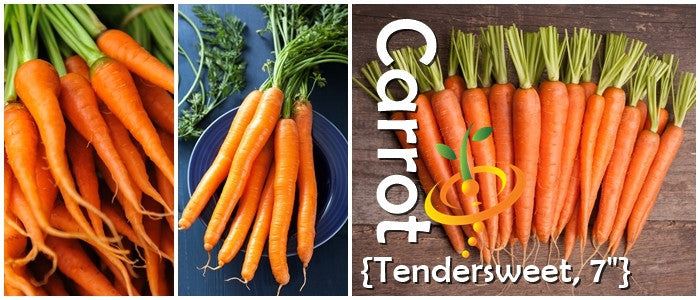
- One of the sweetest and best tasting carrots you can grow!
- Skinny 7" tapered roots
- Easy to grow
- Carrots are a sun-loving plants that also like the cold.
- Just keep them consistently watered and they'll be happy.
-
Days to Maturity | 70 days
- Carrot Seeds | Carrots are an annual cool-season crop, half-hardy to frost and light freezes. Sow seeds evenly in a very shallow furrow, about 1/4 inch deep, and keep seeds moist so they will germinate.
Click here for complete Carrot grow guide
Additional Details
Carrot gets its characteristic and bright orange colour from β-carotene, which is metabolised into vitamin A in humans when bile salts are present in the intestines. Carrots are also rich in dietary fiber, antioxidants, and minerals.
- One of the sweetest and best tasting carrots you can grow!
- From $099 USDUnit price /Unavailable
Description

- Catmint has a long history of use as a household herbal remedy, being employed especially in treating disorders of the digestive system and, as it stimulates sweating, it is useful in reducing fevers
- Catmint is considered to be beneficial in the treatment of fevers and colds
- It is also very useful in the treatment of restlessness and nervousness, being very useful as a mild nervine for children
-
Days to Maturity | 65 days
Want more? View our entire collection of high-potency Medicinal Herb seed varieties.
See Catmint Recipes & Growing Tips on our Pinterest Board
Follow SeedsNow.com's board Catmint on Pinterest. - Catmint has a long history of use as a household herbal remedy, being employed especially in treating disorders of the digestive system and, as it stimulates sweating, it is useful in reducing fevers
- From $299 USDUnit price /Unavailable
Description

- This Cauliflower variety produces large white heads and surrounded by dark green leaves
- Continues to grow well for a long time
- Suitable for successional sowing all year round
-
Days to Maturity | 65 days
- Cauliflower is an annual cool-season crop, half-hardy to frost and light freezes. Plant in rows 2 1/2 to 3 feet apart, with 2 feet between plants.
Click here for complete Cauliflower grow guide
- From $399 USDUnit price /Unavailable
Description

- The Igloo Cauliflower produces snowball type white heads
- Produces large dense leaves that protect the solid white heads from frost
- Excellent variety for the cooler months
- Days to Maturity | 65-70 days
-
Cauliflower Seeds | Cauliflower is an annual cool-season crop, half-hardy to frost and light freezes. Plant in rows 2 1/2 to 3 feet apart, with 2 feet between plants.
Click here for complete Cauliflower grow guide
Cauliflower - Snowball/Self-blanche (White)
From $399 USDUnit price /UnavailableDescription

- The Self-Blanche Cauliflower produces flavorful snow ball type cauliflower
- Plant early as it stops growing when it gets hot
- The leaves curl upward and cover head to keep sun from ruining white color
-
Days to Maturity | 65 days
-
Cauliflower Seeds | Cauliflower is an annual cool-season crop, half-hardy to frost and light freezes. Plant in rows 2 1/2 to 3 feet apart, with 2 feet between plants.
Click here for complete Cauliflower grow guide
- The Self-Blanche Cauliflower produces flavorful snow ball type cauliflower
Cauliflower - Violetta (Purple)
From $399 USDUnit price /UnavailableDescription
- This Cauliflower variety produces large purple heads and surrounded by dark green leaves
- Continues to grow well for a long time
- Suitable for successional sowing all year round -
Days to Maturity | 65 days
-
Cauliflower Seeds | Cauliflower is an annual cool-season crop, half-hardy to frost and light freezes. Plant in rows 2 1/2 to 3 feet apart, with 2 feet between plants.
Click here for complete Cauliflower grow guide
- This Cauliflower variety produces large purple heads and surrounded by dark green leaves
- From $399 USDUnit price /Unavailable
Description

German Chamomile has been cultivated as a medicinal herb for thousands of years and was used by ancient Egyptians, Romans, Greeks, and Vikings. An easy care annual in the daisy family, it has small white flowers with large yellow hollow cone centers that proliferate on a bushy shrub of feathery foliage. Only the sweet apple-scented flowers are used fresh or dried, usually steeped into a soothing herbal tea that can be used as a facial tonic or sipped by kids and adults right before it’s time to go night-night.
As a companion plant, it attracts pollinators and beneficial insects; repels cabbage moths, cabbage white fly, cabbage worms, cucumber beetles, and mosquitoes; and is said to increase the fragrance and flavor of aromatic herbs such as basil, mint, oregano, rosemary, sage, and thyme.
Roman Chamomile has many of the same uses, but is a low-growing, evergreen perennial groundcover with fewer, but larger flowers. You can determine which type of Chamomile you have if you cut open the yellow center of the flower. Roman has solid centers while German has hollow ones.
As a medicinal herb, Chamomile has been used internally to treat allergies, anxiety, arthritis, asthma, colds, colic, cough, flatulence, gum disease, headache, indigestion, inflammation, insomnia, irritable bowel syndrome (IBS), menstrual cramps, morning sickness, stress, nervousness, restlessness, and stomach upset, and externally to treat burns, earache, hemorrhoids, mouth sores, skin problems, sunburns, teething pain, tired eyes, toothache, and wounds.
⚠️ Do not handle or ingest if you are allergic to ragweed.
⚠️ Medicinal properties are presented as information only, and are not a recommendation or prescription for use. Consult a medical professional before using any herb medicinally.
- Abundant blossoms
- Apple fragrance
- Grows 2'-3' tall
- Good for containers
SEED PLANTING TIPS
- Botanical name: Matricaria chamomilla
- Life cycle: Herbaceous annual
- Hardiness zones: 4-9
- Planting season: Spring, fall
- Days to maturity: 55-70 days
- Depth to plant seeds: Lightly cover - seeds need light to germinate
- Days to germinate (sprout): 7-21 days
- Germination soil temps: 55F-75F
- Spacing between plants: 12"-18" apart
- Spacing between rows: 18"-24" apart
- # of plants per sq. ft.: Appx. 1 plant per sq. ft.
- Soil types: Sandy, loamy, silty, shallow, poor, rich, moist, well-drained
- Soil pH: 5.0-7.5
- Sun needs: Full sun, part shade
- Water needs: Low - do not overwater
- Cold stratify: Yes
- Frost tolerant: Yes
- Heat tolerant: Yes
- Drought tolerant: Yes
- Deer resistant: Yes
- Culinary use: No
- Medicinal use: Yes
Good companion plants: Basil, Bean, Broccoli, Brussels Sprouts, Cabbage, Carrot, Cauliflower, Chives, Collards, Cucumber, Fava Bean, Garlic, Hyssop, Kale, Lavender, Marigold, Mint, Mustard, Onion, Oregano, Pepper, Parsley, Rosemary, Soybean, Sage, Thyme, Squash, Tomato, Zucchini
More facts about Chamomile:
- Chamomile helps combat headaches, toothaches, and earaches.
- Sometimes known as "the plant doctor", because it is thought to help the growth and health of many other plants, especially ones that produce essential oils.
- Thought to increase production of those oils, making certain herbs, like mints (spearmint, sage, oregano) and basil stronger in scent and flavor.
- Can be taken as a herbal tea, two teaspoons of dried flower per cup of tea, which should be steeped for ten to fifteen minutes while covered to avoid evaporation of the volatile oils.
See Chamomile Recipes & Growing Tips on our Pinterest Board
Follow SeedsNow.com's board Chamomile on Pinterest. - From $399 USDUnit price /Unavailable
Description

Roman Chamomile, also called English Chamomile, has been cultivated as a medicinal herb since Medieval times. This hardy, aromatic, mat-forming groundcover perennial in the daisy family produces small white flowers with large yellow solid cone centers and aromatic, fern-like foliage. Easily spreads through both reseeding and creeping roots, and can become invasive. Use it to fill in space between stones or pavers, or create a fragrant, low-maintenance “chamomile lawn” like the royals do at Buckingham Palace. Both the apple-scented flowers and stems are used fresh or dried, and steeped into a calming herbal tea sipped before beddy-bye time.
Apple fragrance
Grows 3"-6" tall
Can be invasive
Good for containersAs a companion plant, it attracts pollinators and beneficial insects; repels cabbage moths, cabbage white fly, cabbage worms, cucumber beetles, and mosquitoes; and is said to increase the fragrance and flavor of aromatic herbs such as basil, mint, oregano, rosemary, sage, and thyme.
German Chamomile has many of the same uses as Roman Chamomile, but it’s a tall, bushy annual with more, but smaller flowers. You can determine which type of Chamomile you have if you cut open the yellow center of the flower. German has hollow centers while Roman has solid ones.
As a medicinal herb, Chamomile has been used internally to treat allergies, anxiety, arthritis, asthma, colds, colic, cough, flatulence, gum disease, headache, indigestion, inflammation, insomnia, irritable bowel syndrome (IBS), menstrual cramps, morning sickness, stress, nervousness, restlessness, and stomach upset, and externally to treat burns, earache, hemorrhoids, mouth sores, skin problems, sunburns, teething pain, tired eyes, toothache, and wounds.
⚠️ Medicinal properties are presented as information only, and are not a recommendation or prescription for use. Consult a medical professional before using any herb medicinally.
SEED PLANTING TIPS
- Botanical name: Chamaemelum nobile
- Life cycle: Herbaceous perennial
- Hardiness zones: 4-9
- Planting season: Spring, summer, fall
- Days to maturity: 60-65 days
- Depth to plant seeds: Lightly cover - seeds need light to germinate
- Days to germinate (sprout): 7-14 days
- Germination soil temps: 55F-70F
- Spacing between plants: 6"-9" apart
- Spacing between rows: 18"-24" apart
- # of plants per sq. ft.: Appx. 4 plants per sq. ft.
- Soil types: Sandy, loamy, silty, chalky, shallow, poor, rich, moist, well-drained
- Soil pH: 5.5-7.5
- Sun needs: Full sun, part shade
- Water needs: Low - do not overwater
- Cold stratify: No
- Frost tolerant: Yes
- Heat tolerant: No
- Drought tolerant: Yes
- Deer resistant: Yes
- Culinary use: No
- Medicinal use: Yes
Good companion plants: Basil, Bean, Broccoli, Brussels Sprouts, Cabbage, Carrot, Cauliflower, Chives, Collards, Cucumber, Fava Bean, Garlic, Hyssop, Kale, Lavender, Marigold, Mint, Mustard, Onion, Oregano, Pepper, Parsley, Rosemary, Soybean, Sage, Thyme, Squash, Tomato, Zucchini
More facts about Chamomile:
-
Chamomile helps combat headaches, toothaches, and earaches.
- Sometimes known as "the plant doctor", because it is thought to help the growth and health of many other plants, especially ones that produce essential oils.
-
Thought to increase production of those oils, making certain herbs, like mints (spearmint, sage, oregano) and basil stronger in scent and flavor.
- Can be taken as a herbal tea, two teaspoons of dried flower per cup of tea, which should be steeped for ten to fifteen minutes while covered to avoid evaporation of the volatile oils.
See Chamomile Recipes & Growing Tips on our Pinterest Board
Follow SeedsNow.com's board Chamomile on Pinterest. - From $399 USDUnit price /Unavailable
Description
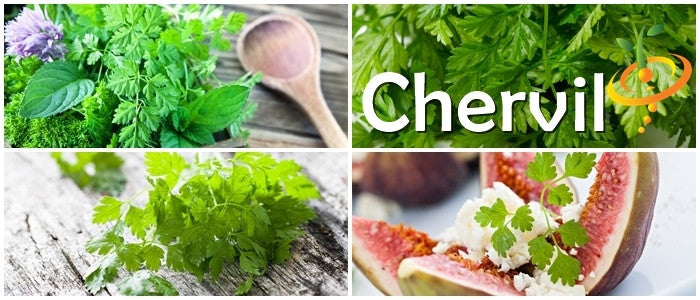
Chervil, also called French Parsley and Garden Chervil, is an ancient aromatic annual in the parsley family, with similar fern-like leaves, tiny white flowers, and a sweet flavor that’s a delicate mix of parsley, anise, and pepper. Leaves, stems, seeds, and flowers are all edible. It prefers growing in part shade in moist soil with cool temps, so it’s good for indoor gardens or fall/winter gardens in mild climates. An important ingredient in fines herbes, along with chives, parsley, and tarragon, used extensively in French gourmet cooking. Loses its flavor when dried, so chop or chiffonade to add a freshness to salads, dressings, herb butter, sauces, seafood, peas, poultry, green beans, carrots, eggs, and herbal tea.
As a companion plant, it attracts pollinators and beneficial insects, and repels ants, aphids, slugs, and snails.
As a medicinal herb, Chervil has been used internally to treat arthritis, bronchitis, congestion, cough, gum disease, hiccups, low blood pressure, menstrual cramps, skin problems, and swelling, and externally to treat painful joints, tired eyes, and wounds.
YIELD Medicinal properties are presented as information only, and are not a recommendation or prescription for use. Consult a medical professional before using any herb medicinally.
- Parsley-anise-pepper flavor
- All parts are edible
- Good for indoor gardens
- Good for containers
SEED PLANTING TIPS
- Botanical name: Anthriscus cerefolium
- Life cycle: Herbaceous annual
- Hardiness zones: 3-10
- Planting season: Spring, fall
- Days to maturity: 40-60 days; can begin harvesting when 6" tall
- Depth to plant seeds: 1/4" deep
- Days to germinate (sprout): 14-28 days
- Germination soil temps: 55F-65F
- Spacing between plants: 9"-12" apart
- Spacing between rows: 18"-24" apart
- # of plants per sq. ft.: Appx. 1 plant per sq. ft.
- Soil types: Sandy, loamy, rich, moist, well-drained
- Soil pH: 6.0-7.5
- Sun needs: Full sun, part shade, full shade
- Water needs: Average
- Cold stratify: No
- Frost tolerant: Yes
- Heat tolerant: No
- Drought tolerant: No
- Deer resistant: Yes
- Culinary use: Yes
- Medicinal use: Yes
Good companion plants: Broccoli, Carrot, Cilantro/Coriander, Dill, Lettuce, Mint, Radish, Yarrow
More facts about Chervil:
- Pregnant women were bathed in an infusion of it; a lotion of it was used as a skin cleanser; and it was used medicinally as a blood purifier.
- It was also claimed to be useful as a digestive aid, for lowering high blood pressure, and, infused with vinegar, for curing hiccups
See Chervil Recipes & Growing Tips on our Pinterest Board
Follow SeedsNow.com's board Chervil on Pinterest. - From $399 USDUnit price /Unavailable
Description

Chives (Allium schoenoprasum) are a versatile perennial allium that delivers delicate onion flavor to culinary applications. This hardy herb establishes quickly in garden beds or containers, preferring full sun and moderately fertile, well-draining soil. Chives produce attractive purple-pink flower clusters that bloom throughout spring and summer, offering ornamental appeal alongside culinary utility. Continuous harvesting encourages bushier growth and extends productivity across multiple seasons. The plant's shallow root system makes it an excellent companion in vegetable gardens, and its pungent foliage naturally repels certain garden pests. Exceptionally cold-hardy and drought-tolerant once established, chives require minimal maintenance while providing consistent harvests for soups, salads, and garnishes. An indispensable addition for any edible garden.
- Also known as Allium Scoenoprasum. A perennial plant that grows narrow, grass-like leaves that have a mild onion-like flavor
- Chives are rich in vitamins A and C, contain trace amounts of sulfur, and are rich in calcium and iron
- Used for many culinary creations
- Perfect for containers and small spaces
- The plant will grow to about 12" tall
-
Days to Maturity | 80 days
-
Chives | Chives are grown best in cooler weather, are cold hardy and usually are planted early in the spring. Sow your chive seeds directly into the soil as soon as it is workable and at least 60 degrees F.
Click here for complete Chives grow guide
If you like Chives, try growing Scallions.
See Chive Recipes & Growing Tips on our Pinterest Board
Follow SeedsNow.com's board Chives on Pinterest. - Also known as Allium Scoenoprasum. A perennial plant that grows narrow, grass-like leaves that have a mild onion-like flavor
Cilantro/Coriander, Slow-Bolt (splits)
From $299 USDUnit price /UnavailableDescription

Cilantro is the most popular leafy aromatic herb with a tangy citrusy-parsley-like flavor, used in Latin and Asian cuisines.
Coriander is the dried seed, whole or powdered, with an earthy, floral flavor used as a spice in Indian cuisine. Grow it just for the seeds or the tiny pinkish flowers, which are quite sweet.
Cilantro prefers cool weather, and this slow-bolt variety will tolerate a bit more heat, putting out more leaves for a longer time before it starts bolting out tasty flowers and Coriander seeds.
Leaves, stems, flowers, seeds, and root of this fast-growing herb are all edible. It also likes shady spots, so a good one to grow indoors.
- Citrusy-parsley-like flavor
- All parts are edible
- Grows 1'-2' tall
- Good for indoor gardens
As a companion plant, it attracts pollinators and beneficial insects, and repels aphids, carrot rust fly, grasshoppers, mosquitoes, potato beetles, and spider mites.As a medicinal herb, Coriander has been used internally to treat anxiety, arthritis, bad breath, colic, constipation, diabetes, diarrhea, flatulence, indigestion, inflammation, insomnia, lack of appetite, nausea, nervousness, pain, stomach cramps, and urinary tract infections (UTIs), and externally to treat rheumatism, headache, joint pain, and tired eyes.
⚠️ Medicinal properties are presented as information only, and are not a recommendation or prescription for use. Consult a medical professional before using any herb medicinally.
Good companion plants: Anise, Asparagus, Basil, Broccoli, Brussels Sprouts, Cabbage, Carrot, Celery, Chervil, Collards, Cumin, Dill, Kale, Kohlrabi, Lemongrass, Lettuce, Mint, Mustard, Oregano, Parsley, Parsnip, Pea, Potato, Rutabaga, Spinach, Squash, Tomato, Turnip, Zucchini
More facts about Cilantro/Coriander:
- This slow-bolting strain is grown primarily for its broad, deep green, celery-like, pungent foliage.
- Used in Oriental and Mexican cuisine.
- Use seed to flavor meats, pickles and baked goods.
- Coriander contains antioxidants. It has also been used as a folk medicine for the relief of anxiety and insomnia. Coriander has also been documented as a traditional treatment for diabetes.
See Cilantro/Coriander Recipes & Growing Tips on our Pinterest Board
Follow SeedsNow.com's board Cilantro on Pinterest. - From $399 USDUnit price /Unavailable
Description

- This is the traditional Collard Green variety popularly grown in the south
- These plants produce large yields of dark blue-green cabbage-like leaves
- Tolerates heat, humidity, and poor soil conditions
-
Days to Maturity | 75 day
-
Collards | Plant seeds 3 to 4 weeks before your first frost for Spring harvest. Sow seeds approximately 12" from one another.
Click here for complete Collards grow guide
Additional Details
Collard is widely considered to be a healthy food, collards are good sources of vitamin C and soluble fiber and contain multiple nutrients with potent anti-cancer properties, such as diindolylmethane and sulforaphane.[citation needed] Roughly a quarter pound (approx. 100 g) of cooked collards contains 46 calories.
- This is the traditional Collard Green variety popularly grown in the south
- From $399 USDUnit price /Unavailable
Description

- Extremely tender, medium green leaves are broad and slightly crumpled
- Compact plant forming loose heads of short steamed leaves
- Tolerant of heat and cold and very rich in vitamins and minerals
- The juicy leaves have a mild cabbage-like flavor and are delicious boiled, steamed, or as an addition to salads. 36 inches tall
-
Days to Maturity | 80 days
-
Collards | Plant seeds 3 to 4 weeks before your first frost for Spring harvest. Sow seeds approximately 12" from one another.
Click here for complete Collards grow guide
Additional Details
Collard is widely considered to be a healthy food, collards are good sources of vitamin C and soluble fiber and contain multiple nutrients with potent anti-cancer properties, such as diindolylmethane and sulforaphane.[citation needed] Roughly a quarter pound (approx. 100 g) of cooked collards contains 46 calories.
- Extremely tender, medium green leaves are broad and slightly crumpled
- From $399 USDUnit price /Unavailable
Description

- Extremely tender, medium green leaves are broad and slightly crumpled
- The juicy leaves have a mild cabbage-like flavor and are delicious boiled, steamed, or as an addition to salads
- Tolerant of heat and cold
- Rich in vitamins and minerals
- Plant grows to about 36" tall
-
Days to Maturity | 80 days
-
Collards | Plant seeds 3 to 4 weeks before your first frost for Spring harvest. Sow seeds approximately 12" from one another.
Click here for complete Collards grow guide
Additional Details
Collard is widely considered to be a healthy food, collards are good sources of vitamin C and soluble fiber and contain multiple nutrients with potent anti-cancer properties, such as diindolylmethane and sulforaphane.[citation needed] Roughly a quarter pound (approx. 100 g) of cooked collards contains 46 calories.
- Extremely tender, medium green leaves are broad and slightly crumpled
- From $399 USDUnit price /Unavailable
Description
Rudbeckia amplexicaulis, commonly known as the clasping coneflower, is a perennial plant that belongs to the Asteraceae family. This species is native to the eastern and central regions of North America and is recognized for its distinctive yellow flowers and unique foliage. Understanding the characteristics and cultivation requirements of Rudbeckia amplexicaulis can enhance its integration into a garden setting.
One of the notable features of Rudbeckia amplexicaulis is its growth habit. This plant typically reaches a height of 2 to 3 feet and produces flowers that are approximately 2 to 3 inches in diameter. The flowers are characterized by their bright yellow petals that surround a prominent, dark brown central cone. The foliage is lanceolate and clasping, which gives the plant its common name. The leaves can grow up to 6 inches long and are arranged alternately along the stem.
In terms of cultivation, Rudbeckia amplexicaulis thrives in well-drained soils and prefers full sun to partial shade. It is important to note that this species is drought-tolerant once established, making it an excellent choice for low-maintenance gardens. The ideal soil pH for optimal growth ranges from 6.0 to 7.0. Regular watering during the initial establishment phase is recommended, but overwatering should be avoided to prevent root rot.
Rudbeckia amplexicaulis is also known for its resilience against pests and diseases. This hardiness contributes to its popularity among gardeners seeking sustainable and low-maintenance options. However, it is advisable to monitor for common pests such as aphids and spider mites, which can occasionally affect the plant. Implementing integrated pest management strategies can help mitigate these issues.
In terms of propagation, Rudbeckia amplexicaulis can be easily grown from seeds or divisions. Seeds should be sown in the spring or fall, and germination typically occurs within 14 to 30 days under optimal conditions. For division, it is recommended to separate the plants every 3 to 4 years to maintain vigor and prevent overcrowding.
In addition to its aesthetic appeal, Rudbeckia amplexicaulis serves as an important ecological resource. The flowers attract a variety of pollinators, including bees and butterflies, which contribute to the overall health of the garden ecosystem. Furthermore, the plant's seeds provide food for birds during the winter months, enhancing biodiversity in the garden.
In conclusion, Rudbeckia amplexicaulis is a versatile and resilient perennial that can add significant value to any garden. Its striking flowers, low maintenance requirements, and ecological benefits make it an ideal choice for both novice and experienced gardeners. By understanding its growth habits and cultivation needs, gardeners can successfully incorporate this species into their landscapes, promoting both beauty and sustainability.
Coneflower, Purple Echinacea Flowers
From $399 USDUnit price /UnavailableDescription
Echinacea, also called Purple Coneflower, is an easy care perennial in the daisy family. Blooms bunches of blossoms with lavender petals skirting a brown spiky cone center atop sturdy stems that can grow 2'-4' tall. The leaves, flowers, buds, stems, and roots have been used medicinally for centuries, both dried and fresh, as an herbal tea, tincture, and oil infusion. Plant a deep pot, a small plot, or an entire lot!
- Immune system booster
- Attracts pollinators
- Long-lasting cut flower
- Good for containers
As a medicinal herb, Echinacea supports the immune system and has been used internally as a preventative against colds, flu, and chest congestion. It has also been used internally to treat anxiety, arthritis, asthma, colds, constipation, cough, depression, diphtheria, headache, inflammation, pain, rheumatism, sore throat, stomach cramps, strep throat, tonsillitis, tuberculosis, and whooping cough. Externally, Echinacea has been used to treat insect bites and stings, burns, dry or wrinkled skin, tired eyes, toothache, and wounds.
SEED PLANTING TIPS
- Botanical name: Echinacea purpurea
- Life cycle: Herbaceous perennial
- Hardiness zones: 3-9
- Planting season: Spring, summer, fall
- Days to maturity: 2 years; can begin harvesting when 6" tall
- Depth to plant seeds: Lightly cover - seeds need light to germinate
- Days to germinate (sprout): 7-30 days
- Germination soil temps: 65F-70F
- Spacing between plants: 12"-18" apart
- Spacing between rows: 18"-24" apart
- # of plants per sq. ft.: Appx. 1 plant per sq. ft.
- Soil types: Clay, sandy, loamy, silty, rocky, chalky, shallow, poor, rich, dry, well-drained
- Soil pH: 6.5-7.2
- Sun needs: Full sun, part shade
- Water needs: Low - do not overwater
- Cold stratify: Yes
- Frost tolerant: Yes
- Heat tolerant: Yes
- Drought tolerant: Yes
- Deer resistant: Yes
- Medicinal use: Yes

⚠️ Medicinal properties are presented as information only, and are not a recommendation or prescription for use. Consult a medical professional before using any herb medicinally.
Coneflower, Red Prairie (Mexican Hat) Flowers
From $399 USDUnit price /UnavailableDescription
Ratibida columnifera, commonly known as the prairie coneflower or Mexican hat, is a perennial flowering plant belonging to the Asteraceae family. This species is native to the central and western regions of North America, thriving in a variety of habitats, including prairies, open woodlands, and disturbed areas. Its adaptability to different soil types and conditions makes it a valuable addition to gardens focused on sustainability and biodiversity.
One of the notable characteristics of Ratibida columnifera is its distinctive flower structure. The plant typically features a central cone surrounded by drooping, red petal-like ray florets. The height of the plant can range from 1 to 3 feet, making it suitable for both foreground and background planting in garden designs. The flowering period generally occurs from late spring to early fall, providing a long-lasting display of color.
In terms of ecological benefits, Ratibida columnifera serves as an important nectar source for various pollinators, including bees and butterflies. Studies indicate that native plants like Ratibida columnifera can increase pollinator diversity by up to 50% in garden settings. This makes it an ideal choice for gardeners looking to support local ecosystems and promote pollinator health.
Furthermore, this species is drought-tolerant and requires minimal maintenance once established. It is well-suited for xeriscaping and can thrive in poor soil conditions, making it an excellent option for sustainable gardening practices. Ratibida columnifera can also help prevent soil erosion due to its deep root system, which stabilizes the soil and improves its structure.
When incorporating Ratibida columnifera into a garden, it is advisable to plant it in full sun to partial shade, ensuring that it receives adequate light for optimal growth. Spacing should be considered, as these plants can spread over time. A distance of 12 to 18 inches between plants is recommended to allow for proper air circulation and to minimize competition for nutrients.
In summary, Ratibida columnifera is a versatile and beneficial plant for gardens, particularly those aimed at enhancing biodiversity and sustainability. Its aesthetic appeal, ecological contributions, and low maintenance requirements make it a valuable addition to any garden landscape. By choosing to cultivate this native species, gardeners can contribute to the preservation of local flora and fauna while enjoying the beauty it brings to their outdoor spaces.
Coneflower, Yellow Prairie (Mexican Hat) Flowers
From $399 USDUnit price /UnavailableDescription
The Yellow Prairie Coneflower (Ratibida columnifera), also called Mexican Hat, is the pure yellow form of the native Prairie Coneflower. Grows 15"-24" tall on slender stems with yellow petals that skirt a tall upright cone. This drought-tolerant droopy petaled daisy loves the heat. A cheerful mid-summer pick-me-up that blooms into fall.
- Life cycle: Perennial
- Bloom season: Spring, summer, fall
- Attracts: Birds, bees, butterflies, beneficial insects, and other pollinators
- Flower meaning: Healing, health, strength
SEED PLANTING TIPS
- Botanical name: Ratibida columnifera
- Hardiness zones: 4-9
- Planting season: Spring, fall
- Days to maturity: 2nd year
- Cold stratify: Yes
- Depth to plant seeds: Lightly cover - seeds need light to germinate
- Spacing between plants: 12"-18" apart
- Days to germinate (sprout): 7-21 days
- Germination soil temps: 65F-75F
- Soil types: Clay, sandy, loamy, silty, chalky, rocky, dry, moist
- Soil pH: 6.8-7.2
- Water needs: Average
- Sun needs: Full sun
- Frost tolerant: No
- Drought tolerant: Yes
- Deer resistant: Yes
Cosmos, Orange Sulphur Flowers
From $399 USDUnit price /UnavailableDescription
Orange sulphur cosmos, also known as Cosmos sulphureus, are vibrant and easy-to-grow flowers that can add a pop of color to any garden. If you're looking to brighten up your outdoor space with these stunning blooms, here's everything you need to know about growing orange sulphur cosmos in your garden.
Orange sulphur cosmos are annual flowers that belong to the Asteraceae family. They are native to Mexico and Central America but are now popular in gardens around the world. These flowers are known for their bright orange blooms that attract butterflies and other pollinators.
Aside from their stunning appearance, orange sulphur cosmos offer several benefits to your garden. They attract pollinators like butterflies and bees, helping to support local ecosystems. These flowers also make excellent cut flowers, adding a burst of color to floral arrangements.
Cosmos, Sensations Mix Flowers
From $399 USDUnit price /UnavailableDescription
Cosmos sulphureus, are vibrant and easy-to-grow flowers that can add a pop of color to any garden. If you're looking to brighten up your outdoor space with these stunning blooms, here's everything you need to know about growing yellow sulphur cosmos in your garden.
They are native to Mexico and Central America but are now popular in gardens around the world. These flowers are known to attract butterflies and other beneficial pollinators.
Aside from their stunning appearance, they offer several benefits to your garden. They attract pollinators like butterflies and bees, helping to support local ecosystems. These flowers also make excellent cut flowers, adding a burst of color to floral arrangements.
Cosmos, Yellow Sulphur Flowers
From $299 USDUnit price /UnavailableDescription
Yellow sulphur cosmos, also known as Cosmos sulphureus, are vibrant and easy-to-grow flowers that can add a pop of color to any garden. If you're looking to brighten up your outdoor space with these stunning blooms, here's everything you need to know about growing yellow sulphur cosmos in your garden.
Yellow sulphur cosmos are annual flowers that belong to the Asteraceae family. They are native to Mexico and Central America but are now popular in gardens around the world. These flowers are known for their bright yellow blooms that attract butterflies and other pollinators.
Aside from their stunning appearance, yellow sulphur cosmos offer several benefits to your garden. They attract pollinators like butterflies and bees, helping to support local ecosystems. These flowers also make excellent cut flowers, adding a burst of color to floral arrangements.
Cover Crop - Clover (Medium Red)
From $399 USDUnit price /UnavailableDescription
Medium Red Clover (Trifolium pratense) is a widely recognized cover crop that plays a significant role in sustainable agriculture and gardening practices. This leguminous plant is particularly valued for its ability to improve soil health, enhance biodiversity, and contribute to sustainable farming systems.
One of the primary benefits of using Medium Red Clover as a cover crop is its nitrogen-fixing capability. Clover plants have a symbiotic relationship with Rhizobium bacteria, which allows them to convert atmospheric nitrogen into a form that is accessible to plants. Research indicates that clover can fix approximately 100 to 200 pounds of nitrogen per acre per year, significantly reducing the need for synthetic fertilizers and promoting a more sustainable approach to soil fertility.
In addition to nitrogen fixation, Medium Red Clover also improves soil structure and health. Its deep taproot system helps to break up compacted soil layers, enhancing aeration and water infiltration. This can lead to improved root development for subsequent crops and increased resilience against drought conditions. Studies have shown that cover crops like clover can increase soil organic matter by 0.5 to 1.5 percent over several years, which is crucial for maintaining soil fertility and structure.
Furthermore, Medium Red Clover serves as an excellent weed suppressor. The dense foliage of clover can outcompete many common weeds, reducing the need for herbicides and manual weeding. This natural weed control mechanism not only saves labor but also minimizes chemical inputs, aligning with organic gardening principles.
Medium Red Clover is also beneficial for attracting beneficial insects and pollinators. The flowers of clover are a rich source of nectar and pollen, supporting a diverse ecosystem in the garden. This can lead to improved pollination rates for other crops and contribute to overall biodiversity in the agricultural landscape.
When incorporating Medium Red Clover into a garden or farming system, it is essential to consider the timing of planting and termination. Clover is typically sown in the late summer or early fall, allowing it to establish before winter. It can be terminated in the spring before planting the main crop, either through mowing or tillage, to incorporate its biomass into the soil, thus enhancing nutrient availability for subsequent crops.
In summary, Medium Red Clover is a valuable cover crop that offers numerous benefits, including nitrogen fixation, soil improvement, weed suppression, and support for beneficial insects. Its use in sustainable gardening practices can lead to healthier soils, reduced reliance on chemical inputs, and increased biodiversity, making it an essential component of modern agricultural systems.
Cover Crop - Clover (Red Crimson)
From $499 USDUnit price /UnavailableDescription
Quick Overview
• Biennial
• Bees love clover!
Details
Planted spring, summer or fall, this quick growing clover is the most versatile variety for a green manure to enrich soil. Needs good moisture. Flowers are used for tea. Excellent forage and cover crop. Planting rate: ½ lb. per 1,000 sq. ft.Cover Crop - Clover (White Dutch)
From $499 USDUnit price /UnavailableDescription
Quick Overview
• Perennial
• Chokes out weeds
Details
Perennial. A low-growing perennial clover that forms a nice mat perfect for pathways between beds. It competes well against quckgrass and, although the plants grow over into the beds, they can easily be pulled back with a rake before mowing. As a green manure/cover crop, it fixes nitrogen and since it's perennial, can be plowed in at any time. Pre-inoculated seed. Plant in early spring: April-May. Planting rate: ½ lb per 1,000 sq. ft.; 8-10 lbs per acre for dry land, 10-12 lbs per acre for irrigated land.Cover Crop - Clover (Yellow Sweet Blossom)
From $399 USDUnit price /UnavailableDescription
Quick Overview
• Biennial
• Vigorous
• Sow Spring & Summer
Details
Tremendous green manure and bee pasture. Vigorous grower with long tap roots to help break up compact soil. Can produce up to 125 lb. of nitrogen per acre. Sow in the spring or summer. Planting rate: 1/2 lb per 1,000 sq ftCucumber - Armenian, Long Green (Metki Serpent Melon)
From $299 USDUnit price /UnavailableDescription
- These Armenian cucumber seeds will produce delicious 30" - 36" long dark green cucumbers
- Bitter-free with excellent flavor
-
Excellent slicer and ideal for salads and many culinary dishes
- Easy to grow
-
Days to Maturity | 65 days
-
Cucumber Seeds | Grow cucumbers where a long, warm growing season, minimum 65 days, can be assured. Plant seeds where there is ample space and vines can sprawl, the simplest way is to plant cucumbers in hills.
Click here for complete Cucumber grow guide
- These Armenian cucumber seeds will produce delicious 30" - 36" long dark green cucumbers
Cucumber - Armenian, White (Metki Serpent Melon)
From $399 USDUnit price /UnavailableDescription
- These Armenian cucumber seeds will produce delicious white cucumbers as long as 30"!
- Bitter-free with excellent flavor
-
Excellent slicer and ideal for salads and many culinary dishes
- Easy to grow
-
Days to Maturity | 65 days
-
Cucumber Seeds | Grow cucumbers where a long, warm growing season, minimum 65 days, can be assured. Plant seeds where there is ample space and vines can sprawl, the simplest way is to plant cucumbers in hills.
Click here for complete Cucumber grow guide
- These Armenian cucumber seeds will produce delicious white cucumbers as long as 30"!
- From $299 USDUnit price /Unavailable
Description

The Ashley cucumber is a popular variety among gardeners, particularly those interested in cultivating high-quality vegetables. This cucumber type is known for its exceptional flavor, crisp texture, and versatility in culinary applications. The Ashley cucumber is classified as a slicing cucumber, making it ideal for fresh consumption in salads, sandwiches, or as a refreshing snack.
One of the defining characteristics of the Ashley cucumber is its growth habit. It is a vigorous, high-yielding plant that can produce an abundance of fruit throughout the growing season. Typically, the Ashley cucumber reaches maturity approximately 55 to 60 days after planting, allowing for a relatively quick turnaround from seed to harvest. This rapid growth cycle is particularly advantageous for gardeners looking to maximize their vegetable output within a limited timeframe.
In terms of physical attributes, the Ashley cucumber is characterized by its dark green skin, which is smooth and free from spines. The fruit typically grows to a length of about 8 to 10 inches, making it a suitable size for slicing. The flesh of the Ashley cucumber is firm and has a mild, sweet flavor profile, which is often preferred by consumers over other cucumber varieties.
From a nutritional standpoint, cucumbers, including the Ashley variety, are low in calories and high in water content, making them an excellent choice for hydration. They also provide essential vitamins and minerals, such as vitamin K, vitamin C, and potassium. Incorporating Ashley cucumbers into a balanced diet can contribute to overall health and wellness.
When cultivating Ashley cucumbers, it is important to consider their growing conditions. This variety thrives in well-drained, fertile soil with a pH level between 6.0 and 6.8. Adequate sunlight is crucial, as Ashley cucumbers require at least 6 to 8 hours of direct sunlight per day for optimal growth. Regular watering is also essential, particularly during dry spells, to ensure consistent moisture levels in the soil.
In terms of pest and disease management, the Ashley cucumber is relatively resilient; however, gardeners should remain vigilant for common cucumber pests such as aphids and cucumber beetles. Implementing integrated pest management strategies, including crop rotation and the use of beneficial insects, can help mitigate potential infestations.
In conclusion, the Ashley cucumber variety is an excellent choice for both novice and experienced gardeners. Its rapid growth, high yield, and superior taste make it a valuable addition to any vegetable garden. By providing the appropriate growing conditions and care, gardeners can enjoy a bountiful harvest of Ashley cucumbers, contributing to a diverse and nutritious diet.
Click here for complete Cucumber grow guide
Follow SeedsNow.com's board Cucumbers on Pinterest - From $299 USDUnit price /Unavailable
Description

- This popular picking variety produces smooth, bright-green, 3" fruits with black spines
- Extremely strong plant
- Grows continually if kept picked
- Excellent cucumber variety for any garden
-
Days to Maturity | 50-55 days
-
Cucumber Seeds | Grow cucumbers where a long, warm growing season, minimum 65 days, can be assured. Plant seeds where there is ample space and vines can sprawl, the simplest way is to plant cucumbers in hills.
Click here for complete Cucumber grow guide
- This popular picking variety produces smooth, bright-green, 3" fruits with black spines
- From $299 USDUnit price /Unavailable
Description

- The Chinese Snake (Curved) cucumber produces fruits that are smooth, dark-green with white spines
- The fruits grow to about 15" to 18" long and curved
- Grows on strong & vigorous vines
-
Days to Maturity | 75 days
-
Cucumber Seeds | Grow cucumbers where a long, warm growing season, minimum 65 days, can be assured. Plant seeds where there is ample space and vines can sprawl, the simplest way is to plant cucumbers in hills.
Click here for complete Cucumber grow guide
- The Chinese Snake (Curved) cucumber produces fruits that are smooth, dark-green with white spines
Cucumber - Cucamelon, West Indian Burr Gherkin
From $299 USDUnit price /UnavailableDescription

-
Also known as: known as Cackrey, Maroon Cucumber, West Indian Gherkin, and West Indian Gourd.
- Incredibly small, cucumber-shaped fruits.
- The surface of these tiny fruits are covered with spine-like warts, while the flesh is pale green.
- Easy to grow for everyone, sells great at farmers markets!
- Can be cooked or eaten raw. The flavor is similar to that of other more traditional cucumbers.
-
Days to Maturity | 55 - 65 days
Click Here For Our Complete Cucumber Grow Guide
-
Also known as: known as Cackrey, Maroon Cucumber, West Indian Gherkin, and West Indian Gourd.
- From $299 USDUnit price /Unavailable
Description

-
The Ever-bearing cucumber is one of the most popular cucumbers you can grow.
- As its name implies, this cucumber variety continues to grow as its fruits are picked
- Crisp fruit with excellent flavor and crunch
- Vigorous vines loaded with fresh cucumbers all season
- Great for table use, slicing, pickling and/or processing
-
Days to Maturity | 60 days
-
Cucumber Seeds | Grow cucumbers where a long, warm growing season, minimum 65 days, can be assured. Plant seeds where there is ample space and vines can sprawl, the simplest way is to plant cucumbers in hills.
Click here for complete Cucumber grow guide
Follow SeedsNow.com's board Cucumbers on Pinterest. -
The Ever-bearing cucumber is one of the most popular cucumbers you can grow.
- From $299 USDUnit price /Unavailable
Description

- The Homemade Pickles variety is one of the best cucumber varieties you can grow to make your own home-grown pickles
- Extremely strong plant - resistant to common cucumber diseases
- Produces a large amount of delicious small to medium sized cucumbers on a compact vine
- Produces a lot over a long season
- Ideal for container gardening and for anyone with limited growing space!
-
Days to Maturity | 55 days
-
Cucumber Seeds | Grow cucumbers where a long, warm growing season, minimum 65 days, can be assured. Plant seeds where there is ample space and vines can sprawl, the simplest way is to plant cucumbers in hills.
Click here for complete Cucumber grow guide
Follow SeedsNow.com's board Cucumbers on Pinterest. - The Homemade Pickles variety is one of the best cucumber varieties you can grow to make your own home-grown pickles
- From $299 USDUnit price /Unavailable
Description

- The Lemon Cucumber is a very popular and rare Heirloom variety that resembles a bright yellow lemon
- Produces 3-4"-inch oval/round cucumbers
- They taste so good you'll be looking forward to eating them straight from the garden
- A popular cucumber variety for anyone who likes cucumbers
-
Days to Maturity | 75 days
-
Cucumber Seeds | Grow cucumbers where a long, warm growing season, minimum 65 days, can be assured. Plant seeds where there is ample space and vines can sprawl, the simplest way is to plant cucumbers in hills.
Click here for complete Cucumber grow guide
Follow SeedsNow.com's board Cucumbers on Pinterest. - The Lemon Cucumber is a very popular and rare Heirloom variety that resembles a bright yellow lemon
- From $299 USDUnit price /Unavailable
Description

- The Marketer cucumber is a popular All-America Selections (AAS) Winner!
- Produces extremely flavorful 9" long (or longer) dark green cucumbers
- Excellent for slicing and salads
- Perfect for any sized home garden (and market growers) -
Days to Maturity | 55 days
-
Cucumber Seeds | Grow cucumbers where a long, warm growing season, minimum 65 days, can be assured. Plant seeds where there is ample space and vines can sprawl, the simplest way is to plant cucumbers in hills.
Click here for complete Cucumber grow guide
Follow SeedsNow.com's board Cucumbers on Pinterest. - The Marketer cucumber is a popular All-America Selections (AAS) Winner!
- From $299 USDUnit price /Unavailable
Description

-
Marketmore cucumbers are a very popular and productive cucumber variety.
- Fruits grow 8"-9" long and 2" across.
- Smooth and dark green skin.
- This is one of our best selling cucumber varieties.
- Easy to grow.
- Excellent flavor.
-
Days to Maturity | 55 days
-
Cucumber Seeds | Grow cucumbers where a long, warm growing season, minimum 65 days, can be assured. Plant seeds where there is ample space and vines can sprawl, the simplest way is to plant cucumbers in hills.
Click here for complete Cucumber grow guide
Follow SeedsNow.com's board Cucumbers on Pinterest. -
Marketmore cucumbers are a very popular and productive cucumber variety.
- From $299 USDUnit price /Unavailable
Description

-
The Muncher cucumber is a delicious variety perfect for munching right out of the garden!
- Excellent flavor and taste
- Medium sized fruits
- Easy to grow
-
Days to Maturity | 60 days
-
Cucumber Seeds | Grow cucumbers where a long, warm growing season, minimum 65 days, can be assured. Plant seeds where there is ample space and vines can sprawl, the simplest way is to plant cucumbers in hills.
Click here for complete Cucumber grow guide
-
The Muncher cucumber is a delicious variety perfect for munching right out of the garden!
- From $299 USDUnit price /Unavailable
Description

- The National Pickling cucumber is an extremely prolific, old-fashioned cucumber variety
- Extremely popular cucumber variety
- Produces 6" long, medium green, with black spines
- Perfect sliced or even for pickling (great for making dill pickles)
- One of the most popular varieties for the home grower
-
Days to Maturity | 55 days
-
Cucumber Seeds | Grow cucumbers where a long, warm growing season, minimum 65 days, can be assured. Plant seeds where there is ample space and vines can sprawl, the simplest way is to plant cucumbers in hills.
Click here for complete Cucumber grow guide
- The National Pickling cucumber is an extremely prolific, old-fashioned cucumber variety
- From $299 USDUnit price /Unavailable
Description

- The Space Master Cucumber is an ideal choice for gardeners seeking high yields in limited space. This compact variety thrives in garden beds and containers, producing crisp, flavorful cucumbers with minimal vine spread. Its disease resistance and rapid growth make it suitable for both novice and experienced growers aiming for efficient, productive harvests. Perfect for fresh salads or pickling, the Space Master cucumber combines superior quality with space-saving benefits.
- It's the perfect cucumber variety for gardeners that want to grow cucumbers in limited space.
- Plant has short vines
- Extremely compact cucumber plant
- produces excellent yields of delicious green cucumbers -
Day to Maturity | 60 days
- Cucumber Seeds | Grow cucumbers where a long, warm growing season, minimum 65 days, can be assured. Plant seeds where there is ample space and vines can sprawl, the simplest way is to plant cucumbers in hills.
Click here for complete Cucumber grow guideFollow SeedsNow.com's board Cucumbers on Pinterest. - The Space Master Cucumber is an ideal choice for gardeners seeking high yields in limited space. This compact variety thrives in garden beds and containers, producing crisp, flavorful cucumbers with minimal vine spread. Its disease resistance and rapid growth make it suitable for both novice and experienced growers aiming for efficient, productive harvests. Perfect for fresh salads or pickling, the Space Master cucumber combines superior quality with space-saving benefits.
- From $299 USDUnit price /Unavailable
Description

- The Straight Eight cucumber variety is a popular heirloom type of cucumber ideal for slicing and/or for eating fresh right off the vine
- They're great when eaten fresh or used in salads
- Pick them off the vine as soon as they are 8" long
- Easy to grow and excellent flavor
-
Days to Maturity | 60 days
-
Cucumber Seeds | Grow cucumbers where a long, warm growing season, minimum 65 days, can be assured. Plant seeds where there is ample space and vines can sprawl, the simplest way is to plant cucumbers in hills.
Click here for complete Cucumber grow guide
- The Straight Eight cucumber variety is a popular heirloom type of cucumber ideal for slicing and/or for eating fresh right off the vine
Cucumber - Tendergreen Burpless
From $299 USDUnit price /UnavailableDescription

- The Tendergreen Burpless cucumber variety is extremely sweet and tender
- Produces medium sized green fruits
- Pick when they grow to 8"
- Also used for pickling if picked less than 8"
-
Days to Maturity | 65 days
-
Cucumber Seeds | Grow cucumbers where a long, warm growing season, minimum 65 days, can be assured. Plant seeds where there is ample space and vines can sprawl, the simplest way is to plant cucumbers in hills.
Click here for complete Cucumber grow guide
- The Tendergreen Burpless cucumber variety is extremely sweet and tender
- From $299 USDUnit price /Unavailable
Description

- Rare white heirloom cucumber variety
- Produces beautiful white cucumbers about 6" long x 2" thick
- Heat tolerant
- Excellent variety for any sized backyard garden, raised beds, or containers
- Amazing flavor and very tender
-
Days to Maturity | 55-60 days
-
Cucumber Seeds | Grow cucumbers where a long, warm growing season, minimum 65 days, can be assured. Plant seeds where there is ample space and vines can sprawl, the simplest way is to plant cucumbers in hills.
Click here for complete Cucumber grow guide
Follow SeedsNow.com's board Cucumbers on Pinterest. - Rare white heirloom cucumber variety
- From $399 USDUnit price /Unavailable
Description

- Annual
- 3 ft. plant with strongly aromatic foliage, stems, and heads. Excellent for pickling
- Days to Maturity | 65 days
Additional Details
Dill has a very long history of herbal use going back more than 2,000 years. The seeds are a common and very effective household remedy for a wide range of digestive problems. An infusion is especially efficacious in treating gripe in babies and flatulence in young children. The seed is aromatic, carminative, mildly diuretic, galactogogue, stimulant and stomachic.
Other Medicinal Properties
Dill is also used in the form of an extracted essential oil. Used either in an infusion, or by eating the seed whole, the essential oil in the seed relieves intestinal spasms and griping, helping to settle colic. Chewing the seed improves bad breath. Dill is also a useful addition to cough, cold and flu remedies, it can be used with antispasmodics such as Viburnum opulus to relieve period pains. Dill will also help to increase the flow of milk in nursing mothers and will then be taken by the baby in the milk to help prevent colic.
See Dill Recipes & Growing Tips on our Pinterest Board
Follow SeedsNow.com's board Dill on Pinterest. - Annual
- From $399 USDUnit price /Unavailable
Description
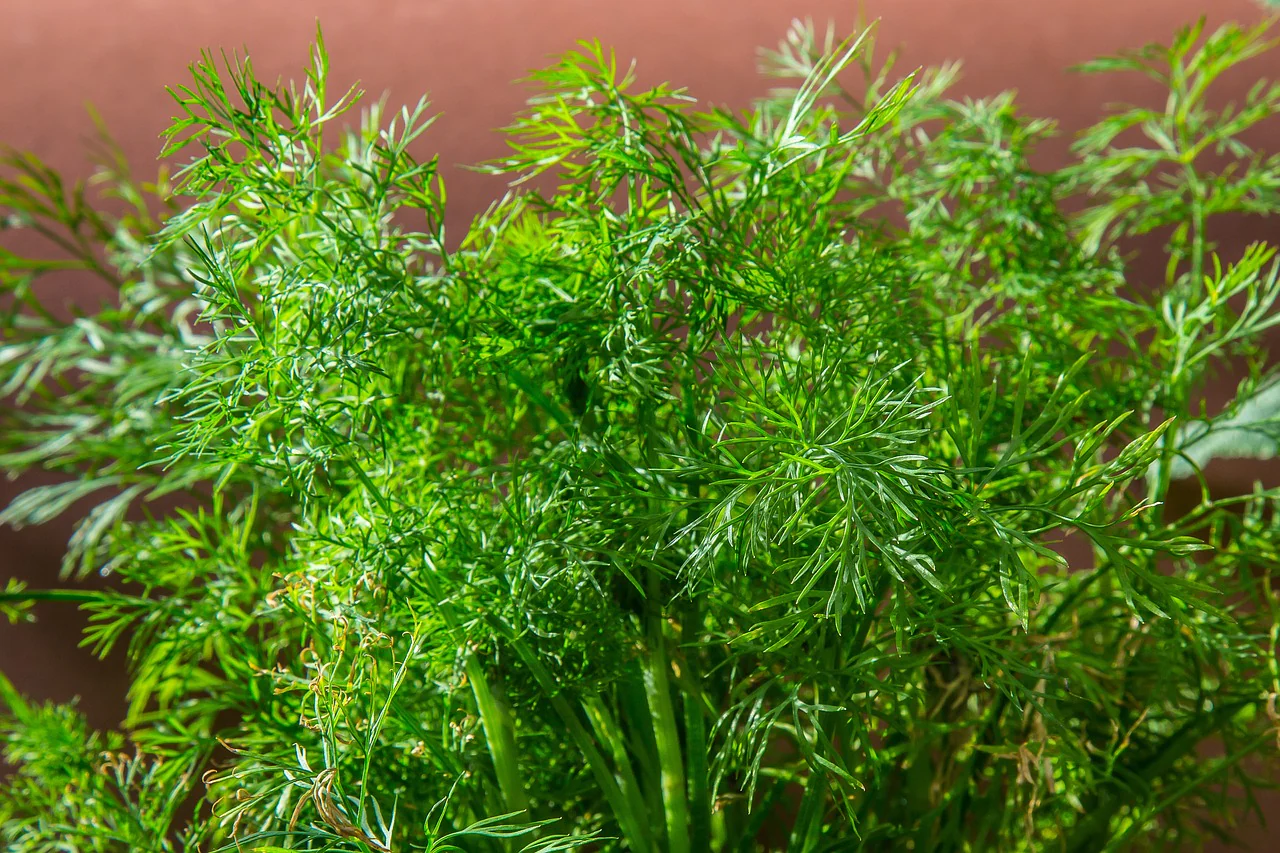
- Dukat dill is a particularly fine plant with amazing flavor and large heads. If you like dill you will love to try this new variety in your garden
- This variety is darker than most other dill varieties.
- Excellent fresh or dried.
- Grown for homemade dill pickles.
- Can be grown in containers, raised beds, and any other location in full sun.
- Annual plant.
- Adds great flavor and color to many culinary creations.
Additional Details
Dill has a very long history of herbal use going back more than 2,000 years. The seeds are a common and very effective household remedy for a wide range of digestive problems. An infusion is especially efficacious in treating gripe in babies and flatulence in young children. The seed is aromatic, carminative, mildly diuretic, galactogogue, stimulant and stomachic.
Other Medicinal Properties
Dill is also used in the form of an extracted essential oil. Used either in an infusion, or by eating the seed whole, the essential oil in the seed relieves intestinal spasms and griping, helping to settle colic. Chewing the seed improves bad breath. Dill is also a useful addition to cough, cold and flu remedies, it can be used with antispasmodics such as Viburnum opulus to relieve period pains. Dill will also help to increase the flow of milk in nursing mothers and will then be taken by the baby in the milk to help prevent colic.
See Dill Recipes & Growing Tips on our Pinterest Board
Follow SeedsNow.com's board Dill on Pinterest. - Dukat dill is a particularly fine plant with amazing flavor and large heads. If you like dill you will love to try this new variety in your garden
- From $399 USDUnit price /Unavailable
Description
- Annual plant
- Adds great flavor and color to many culinary creations
- 3 ft. plant with strongly aromatic foliage, stems, and heads
- Excellent for fresh pickling
-
Days to Maturity | 40 - 65 days
Additional Details
Dill has a very long history of herbal use going back more than 2,000 years. The seeds are a common and very effective household remedy for a wide range of digestive problems. An infusion is especially efficacious in treating gripe in babies and flatulence in young children. The seed is aromatic, carminative, mildly diuretic, galactogogue, stimulant and stomachic.
Other Medicinal Properties
Dill is also used in the form of an extracted essential oil. Used either in an infusion, or by eating the seed whole, the essential oil in the seed relieves intestinal spasms and griping, helping to settle colic. Chewing the seed improves bad breath. Dill is also a useful addition to cough, cold and flu remedies, it can be used with antispasmodics such as Viburnum opulus to relieve period pains. Dill will also help to increase the flow of milk in nursing mothers and will then be taken by the baby in the milk to help prevent colic.
See Dill Recipes & Growing Tips on our Pinterest Board
Follow SeedsNow.com's board Dill on Pinterest. - From $399 USDUnit price /Unavailable
Description

- Fruits are a deep-purple, egg-shaped globe about 6 by 5 inches
- Flesh is smooth, creamy and pale yellow
-
Days to Maturity | 80 days
-
Eggplant Seeds | Start seed indoors to allow at least 10 weeks for young plants to develop. Plant in rows 3 feet apart, with 2 feet between plants.
Click here for complete Eggplant grow guide
- Fruits are a deep-purple, egg-shaped globe about 6 by 5 inches
🌱 Featured Seed Types (A - Z)
View allcontinue shopping
































































































